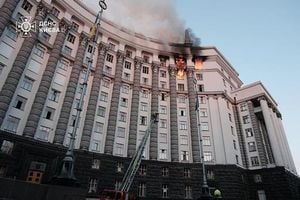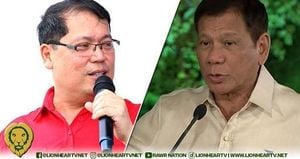On August 25, 2025, a momentous meeting took place at the White House in Washington, D.C., where South Korean President Lee Jae Myung met with U.S. President Donald Trump. The summit, documented in over 40 official photographs released by the White House on September 1, 2025, marked a pivotal chapter in the evolving alliance between the two nations. The images, uploaded to the White House’s official Flickr account, provide a vivid visual account of the day’s events, capturing both the ceremonial grandeur and the subtle gestures of diplomacy that defined the Korea-U.S. summit.
According to Korea JoongAng Daily, the photo series begins with President Trump greeting President Lee at the West Wing entrance, a handshake signaling the start of high-level talks. In one notable image, Trump is seen guiding Lee toward the Oval Office, setting a tone of mutual respect and anticipation. The summit was not only about policy and partnership; it was also about symbolism and personal connection.
Before the formal talks commenced, President Lee signed the White House guestbook in the Roosevelt Room. In brown ink and in his native Korean, Lee wrote, “A new era of a strong and great future begins in the golden age of the Korea-U.S. alliance. August 25, 2025. President of the Republic of Korea, Lee Jae Myung.” The message, as captured in the official photographs, underscored the significance of the moment and Lee’s aspirations for the relationship between the two countries.
Inside the Oval Office, the summit unfolded with both leaders joined by key aides. President Lee was accompanied by his chief of staff, Kang Hoon-sik, and an interpreter, while President Trump sat at the Resolute Desk. One striking photograph shows Lee leaning in, his left hand resting on the desk and his right hand extended as he addressed Trump. The scene was intimate yet charged with the weight of international diplomacy.
Adding a personal touch to the proceedings, President Trump presented several red “Make America Great Again” caps, each signed by him, as gifts for President Lee and the Korean delegation. The caps, neatly arranged on the Resolute Desk, became instant symbols of goodwill. As the two leaders exchanged commemorative gifts, they also took time for photos, shaking hands and smiling for the cameras—a gesture that, while simple, carried the message of unity and shared purpose.
The summit continued with a working luncheon in the White House Cabinet Room. President Lee was joined by Foreign Minister Cho Hyun and Industry Minister Kim Jung-kwan, while the flags of Korea and the United States stood prominently in the background. The atmosphere, as depicted in the released photographs, was one of collaboration and mutual respect. According to Korea JoongAng Daily, the luncheon provided an opportunity for both sides to delve deeper into issues of economic cooperation, security, and regional stability.
At one point during the meeting, President Trump pointed to a television monitor in the Oval Office, which was displaying a Fox News segment about the summit. The moment, captured in a candid photograph, illustrated Trump’s characteristic showmanship as well as his desire to highlight the significance of the event to both domestic and international audiences.
While the summit in Washington signaled a renewed commitment to the Korea-U.S. alliance, events unfolding in Seoul offered another window into President Lee’s leadership. On September 1, 2025, just days after his return from the United States, President Lee presided over a promotion ceremony for South Korea’s army, navy, and air force service chiefs. During the ceremony, Lee ordered senior military leaders to pledge loyalty not to political power, but to the people of South Korea—a move widely interpreted as an effort to restore public trust in the military.
According to a news release from South Korea’s presidential office, Lee addressed General Jin Yong-sung, who had been nominated the previous day to lead the Joint Chiefs of Staff. Lee instructed Jin to remain “loyal to the country, rather than to power,” emphasizing the importance of democratic principles in military leadership. The ceremony, attended by top generals and broadcast by national media, was a direct response to the turbulence that had rocked South Korea’s political and military institutions in recent months.
President Lee’s call for loyalty to the people came in the wake of a failed attempt by his predecessor, former President Yoon Suk Yeol, to impose martial law on December 3, 2024. Yoon’s declaration, which cited political unrest linked to mounting impeachment charges and criminal probes involving the first lady, prompted widespread outcry. The National Assembly impeached Yoon on December 15, and the Constitutional Court upheld the decision on April 4. A special counsel later indicted Yoon on abuse of power and related charges, and lawmakers scrutinized the military’s role after 300 special forces troops were deployed to block lawmakers from voting on ending the emergency order.
The crisis reached a dramatic peak when Lee, then head of the Democratic Party, live-streamed himself climbing the walls of the National Assembly building to bypass the military blockade and cast his vote. The aftermath saw dozens of senior officers dismissed or relieved of duty, the resignation and jailing of then-Defense Minister Kim Yong-hyun, and a nationwide reckoning with the role of the armed forces in a democracy.
Addressing the generals on September 1, Lee did not mince words. “Public trust in the military has declined, due to illegal martial law,” he said, according to the presidential office. He urged the nation’s service members to remember that they are “not loyal to political groups but to the sovereign people … and also need to cultivate their knowledge in democracy.” The loyalty pledge, Lee explained, was a crucial step in restoring trust and stability within South Korea’s military leadership.
Taken together, the events of late August and early September 2025 paint a portrait of President Lee as both a statesman on the world stage and a reformer at home. His summit with President Trump was marked by ceremony, symbolism, and a reaffirmation of the Korea-U.S. alliance. Back in Seoul, his efforts to heal the wounds left by political turmoil and to reestablish the military’s commitment to democratic values signaled a new direction for South Korea’s civil-military relations.
As the images from the White House and the words from the Seoul ceremony make clear, Lee’s presidency is defined by his ability to navigate both international diplomacy and domestic challenges. Whether shaking hands with the U.S. president or addressing his nation’s generals, Lee’s message is consistent: the future of South Korea depends on strong alliances abroad and unwavering loyalty to the people at home.
![[Column] How Seoul can navigate its security in a shifting world order](https://thumbor.evrimagaci.org/5bnrSNFq-5hQGSbIMd9bjGinzEs=/200x0/tpg%2Fsources%2F77428fe0-e434-43e7-a154-8fedbd0380cd.jpeg)



